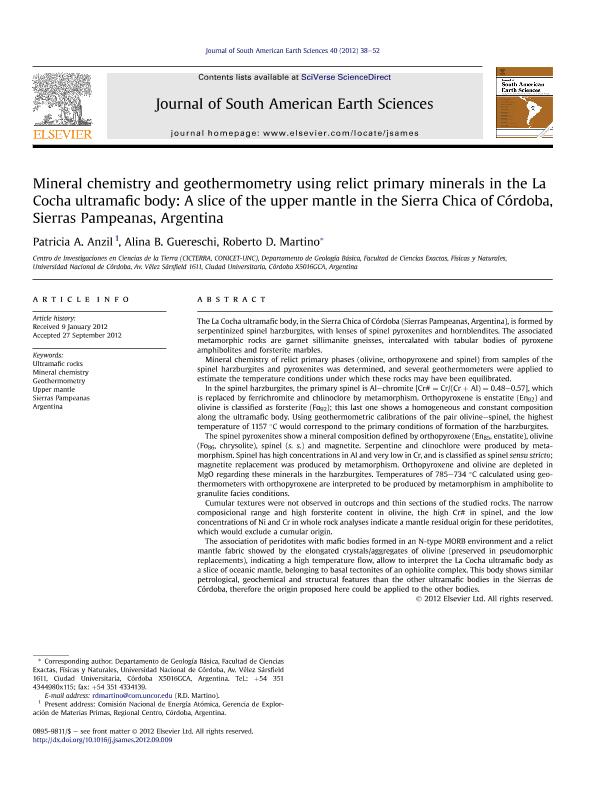Mostrar el registro sencillo del ítem
dc.contributor.author
Anzil, Patricia Andrea

dc.contributor.author
Guereschi, Alina Beatriz

dc.contributor.author
Martino, Roberto Donato

dc.date.available
2018-07-17T14:16:29Z
dc.date.issued
2012-12
dc.identifier.citation
Anzil, Patricia Andrea; Guereschi, Alina Beatriz; Martino, Roberto Donato; Mineral chemistry and geothermometry using relict primary minerals in the La Cocha ultramafic body: A slice of the upper mantle in the Sierra Chica of Córdoba, Sierras Pampeanas, Argentina; Pergamon-Elsevier Science Ltd; Journal of South American Earth Sciences; 40; 12-2012; 38-52
dc.identifier.issn
0895-9811
dc.identifier.uri
http://hdl.handle.net/11336/52356
dc.description.abstract
The La Cocha ultramafic body, in the Sierra Chica of Córdoba (Sierras Pampeanas, Argentina), is formed by serpentinized spinel harzburgites, with lenses of spinel pyroxenites and hornblendites. The associated metamorphic rocks are garnet sillimanite gneisses, intercalated with tabular bodies of pyroxene amphibolites and forsterite marbles.Mineral chemistry of relict primary phases (olivine, orthopyroxene and spinel) from samples of the spinel harzburgites and pyroxenites was determined, and several geothermometers were applied to estimate the temperature conditions under which these rocks may have been equilibrated.In the spinel harzburgites, the primary spinel is Al-chromite [Cr# = Cr/(Cr + Al) = 0.48-0.57], which is replaced by ferrichromite and chlinoclore by metamorphism. Orthopyroxene is enstatite (En92) and olivine is classified as forsterite (Fo92); this last one shows a homogeneous and constant composition along the ultramafic body. Using geothermometric calibrations of the pair olivine-spinel, the highest temperature of 1157 °C would correspond to the primary conditions of formation of the harzburgites.The spinel pyroxenites show a mineral composition defined by orthopyroxene (En85, enstatite), olivine (Fo86, chrysolite), spinel (s. s.) and magnetite. Serpentine and clinochlore were produced by metamorphism. Spinel has high concentrations in Al and very low in Cr, and is classified as spinel sensu stricto; magnetite replacement was produced by metamorphism. Orthopyroxene and olivine are depleted in MgO regarding these minerals in the harzburgites. Temperatures of 785-734 °C calculated using geothermometers with orthopyroxene are interpreted to be produced by metamorphism in amphibolite to granulite facies conditions.Cumular textures were not observed in outcrops and thin sections of the studied rocks. The narrow composicional range and high forsterite content in olivine, the high Cr# in spinel, and the low concentrations of Ni and Cr in whole rock analyses indicate a mantle residual origin for these peridotites, which would exclude a cumular origin.The association of peridotites with mafic bodies formed in an N-type MORB environment and a relict mantle fabric showed by the elongated crystals/aggregates of olivine (preserved in pseudomorphic replacements), indicating a high temperature flow, allow to interpret the La Cocha ultramafic body as a slice of oceanic mantle, belonging to basal tectonites of an ophiolite complex. This body shows similar petrological, geochemical and structural features than the other ultramafic bodies in the Sierras de Córdoba, therefore the origin proposed here could be applied to the other bodies.
dc.format
application/pdf
dc.language.iso
eng
dc.publisher
Pergamon-Elsevier Science Ltd

dc.rights
info:eu-repo/semantics/openAccess
dc.rights.uri
https://creativecommons.org/licenses/by-nc-sa/2.5/ar/
dc.subject
Argentina
dc.subject
Geothermometry
dc.subject
Mineral Chemistry
dc.subject
Sierras Pampeanas
dc.subject
Ultramafic Rocks
dc.subject
Upper Mantle
dc.subject.classification
Meteorología y Ciencias Atmosféricas

dc.subject.classification
Ciencias de la Tierra y relacionadas con el Medio Ambiente

dc.subject.classification
CIENCIAS NATURALES Y EXACTAS

dc.title
Mineral chemistry and geothermometry using relict primary minerals in the La Cocha ultramafic body: A slice of the upper mantle in the Sierra Chica of Córdoba, Sierras Pampeanas, Argentina
dc.type
info:eu-repo/semantics/article
dc.type
info:ar-repo/semantics/artículo
dc.type
info:eu-repo/semantics/publishedVersion
dc.date.updated
2018-07-11T17:46:23Z
dc.journal.volume
40
dc.journal.pagination
38-52
dc.journal.pais
Países Bajos

dc.journal.ciudad
Amsterdam
dc.description.fil
Fil: Anzil, Patricia Andrea. Consejo Nacional de Investigaciones Científicas y Técnicas. Centro Científico Tecnológico Conicet - Córdoba. Centro de Investigaciones en Ciencias de la Tierra. Universidad Nacional de Córdoba. Facultad de Ciencias Exactas Físicas y Naturales. Centro de Investigaciones en Ciencias de la Tierra; Argentina
dc.description.fil
Fil: Guereschi, Alina Beatriz. Consejo Nacional de Investigaciones Científicas y Técnicas. Centro Científico Tecnológico Conicet - Córdoba. Centro de Investigaciones en Ciencias de la Tierra. Universidad Nacional de Córdoba. Facultad de Ciencias Exactas Físicas y Naturales. Centro de Investigaciones en Ciencias de la Tierra; Argentina
dc.description.fil
Fil: Martino, Roberto Donato. Consejo Nacional de Investigaciones Científicas y Técnicas. Centro Científico Tecnológico Conicet - Córdoba. Centro de Investigaciones en Ciencias de la Tierra. Universidad Nacional de Córdoba. Facultad de Ciencias Exactas Físicas y Naturales. Centro de Investigaciones en Ciencias de la Tierra; Argentina
dc.journal.title
Journal of South American Earth Sciences

dc.relation.alternativeid
info:eu-repo/semantics/altIdentifier/url/https://www.sciencedirect.com/science/article/pii/S089598111200137X
dc.relation.alternativeid
info:eu-repo/semantics/altIdentifier/doi/http://dx.doi.org/10.1016/j.jsames.2012.09.009
Archivos asociados
